Experiments With Polarized Light.
by Donald E. Simanek
Screwy Light.
So you've just seen a 3-d movie. I hope you saved those Real-D™ polarizing glasses you paid for. If not, ask at the box office if you could have a few that have been used and will be recycled.The Real-D™ 3-d movie process uses circular polarization, unlike the 3-d movies of the 50s that were presented using linear polarization. If you are into 3-d photography and project your pictures on a screen, you probably have used linear polarizing glasses. Both types of glasses also have other uses, as we shall see. One advantage of the modern glasses for experimentation is that they can be used as either linear or circular polarizers.
Experiments.
Let's demonstrate some of the surprising effects of polarizing glasses. We present these without digressing deeply into the physical explanations. For those who want that, see Experiments with polarized light.
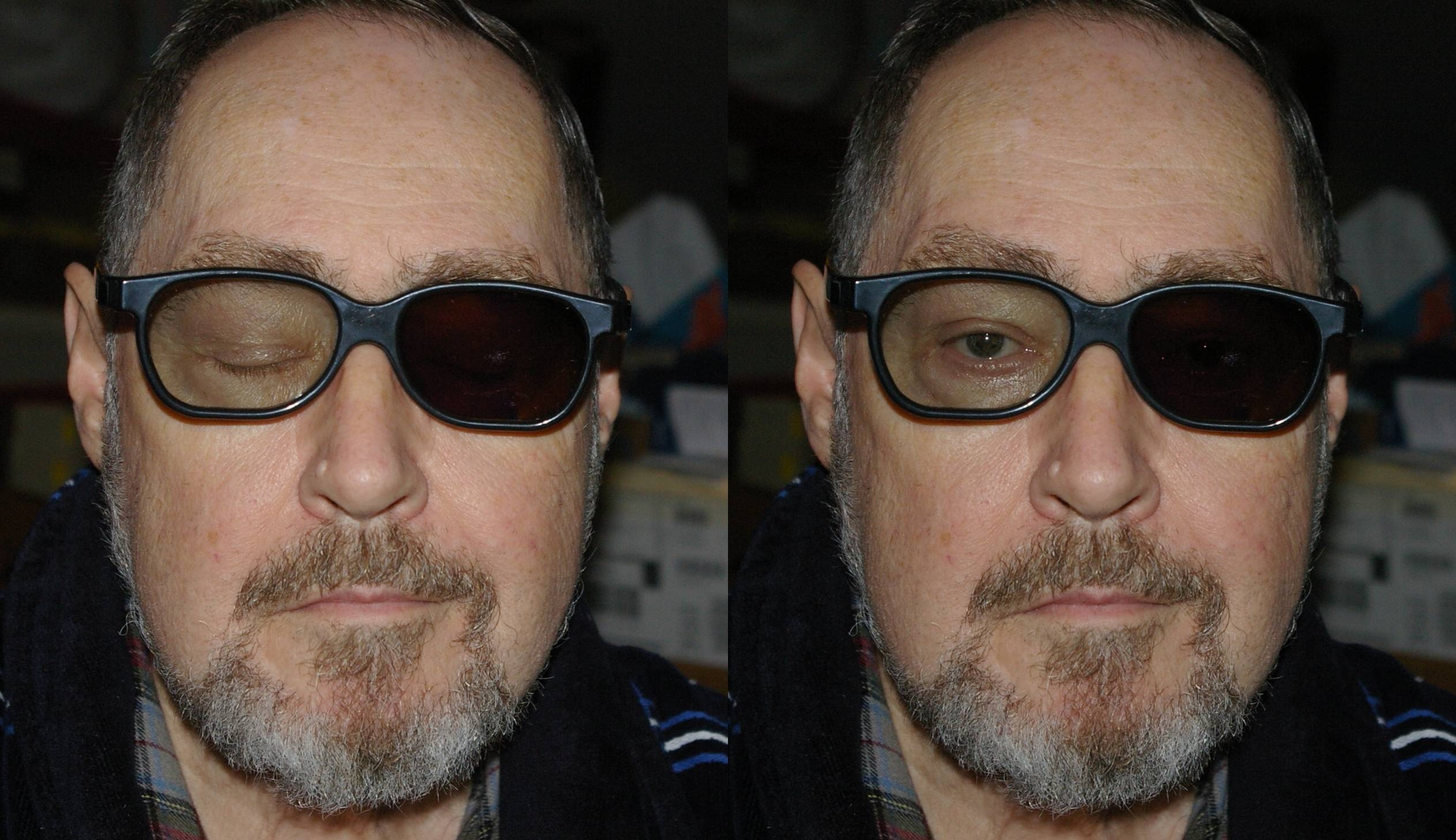 |
| Which picture represents what you will see when you look in a mirror? |
|---|
The spooky eye-patch. Put on the Real-D™ glasses. Look at your reflection in a mirror. Now close one eye. Your image in the mirror shows one of the polarizers appears black—the one over your open eye. You can clearly see your closed eye in the mirror. Think about it. How can your open eye see through the darkened polarizing filter? Go ahead, open both eyes, then close the other one, but predict what will happen before you do it.
Predict what you'd see if, while wearing the glasses, you looked at another person also wearing glasses. Then what would you see if you closed your right eye? Would you then see the other person's left, or right eye?
Place a shiny object, such as a coin, on the table, and look at it through the circularly polarizing glasses. It looks normal, doesn't it? Then remove the glasses and place one of the circular polarizers directly on top of the coin. Now the coin looks dark, black or maybe purple. Flip the polarizer over and note any difference in appearance of the coin. Substitute a pocket mirror for the coin. Try some crumpled metal foil.
 |
| Why does the 50 cent coin (top) appear dark when seen through the circular polarizer, but the 25 cent coin (bottom) seen directly doesn't? |
|---|
Put the glasses in front of your eyes, but with the earpieces forward (not on your ears). Repeat the previous experiments. Explain them all. It helps to remove the earpieces entirely for some of these experiments, for they just get in the way. We may also want to cut them apart at the nosepiece with heavy shears for some experiments.
Each eye has a filter consisting of a linear polarizer sandwiched with a quarter wave plastic retarding sheet. The axes of the polarizer and retarder plates are aligned so one eye's filter acts to pass only left circularly polarized light and the other acts to pass only right circularly polarized light. In both cases the linear polarizing sheets are nearest the eyes.
The light from the theater's silvered screen has the light intended for one eye right circularly polarized and for the other eye it is left circularly polarized. The filters on the glasses select one and reject the other, so each eye sees only the picture intended for it. The orientation of the axis of the linear polarizing layers is irrelevant for the purpose of modern 3-D . If you want more details about the current technology of 3-D movies, see Making Movies Three Dimensional. The bottom line is that if you use the glasses in the normal way, with the ear pieces over your ears, you are looking at light that was circularly polarized, passes through a wave retarding plate then through a linear polarizer so that linearly polarized light reaches your eyes. You might want to label the plastic frame "inside" of the glasses "P" for linear polarizer, and the outside "R" for retarding plate, for future reference.
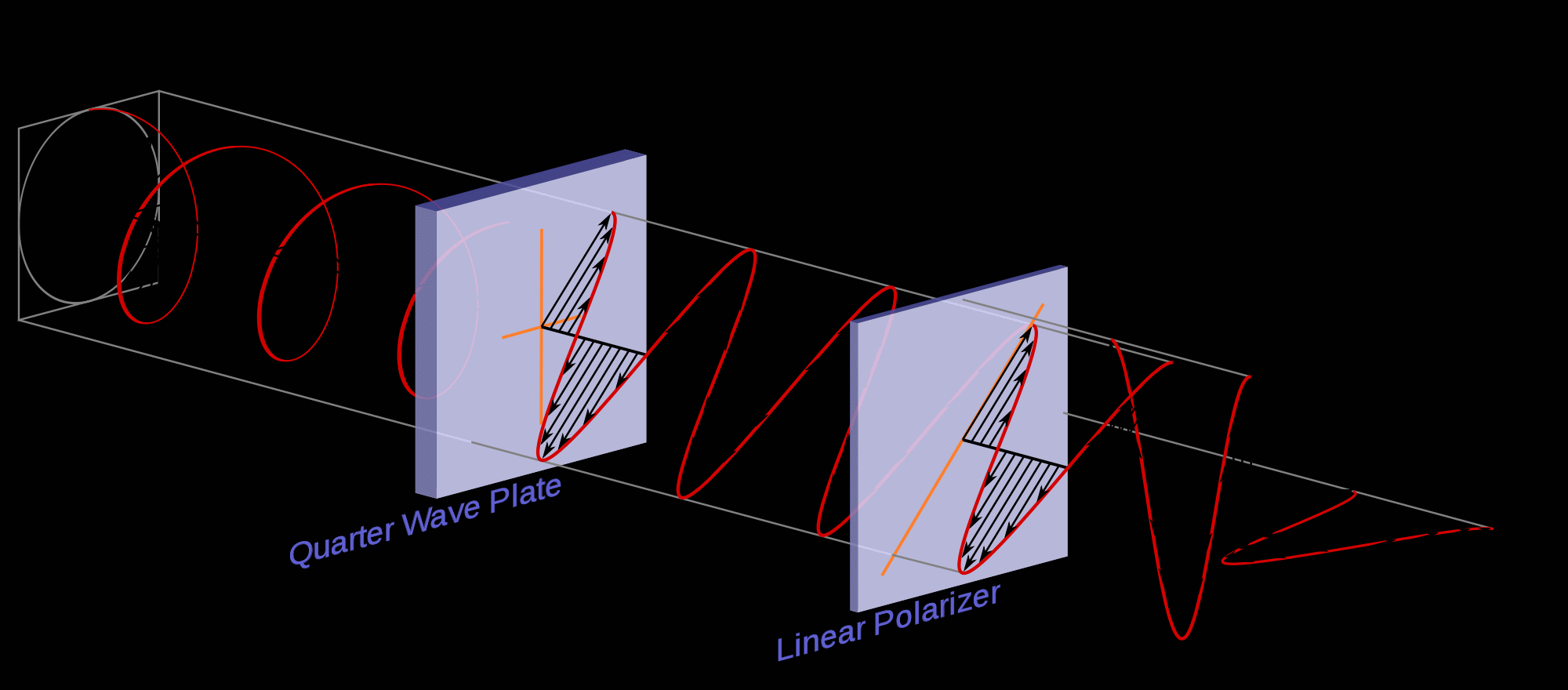 |
| Left handed circular polarization produced by a linear polarizer and a retarding plate. A half wave retardation plate would produce right handed circular polarization. Right handed polarized light can't pass through a left handed polarizer, and vice versa. From the Wikipedia. |
|---|
When you look through the 3-d glasses "backwards" with the retarding plate nearest your eye, the retarder does not affect what you see and the combination acts as a linear polarizer for incoming light. In this way you can do all the standard textbook experiments intended for linear polarizers.
Answer: A reflecting surface flips left circular polarization to right circular polarization and vice versa.
Polarization by reflection. Much light we see in everyday life is partially linearly polarized; reflections from shiny surfaces, for example. Using your glasses backwards (polarizing side away from your eyes), look at shiny surfaces from different angles, and with different polarizer rotation. You will notice that at one orientation of the polarizers, reflections from glass at about 56° (Brewster's angle) to the surface are strongly blocked. In this situation, the polarizer's axis is oriented parallel to the reflecting surface. You might want to mark this axis direction on the glasses' frames for future reference.
Sunglasses. Glasses for 3-d movies are not suitable for use as sunglasses. Polarizing sunglasses have their polarizing axes horizontal, to block reflection from shiny floors, roadways and water surfaces. The movie glasses generally have their polarization axes vertical, so even if worn backwards they wouldn't work as sunglasses.
The light from your computer screen is a bit strange. And it's not just because of the websites you visit. If you have a computer with a flat screen liquid crystal display, turn it on. Open your word processor to display the "writer's block" screen (pure white). Now hold the polarizing glasses with the earpieces toward the screen. Rotate the glasses, and you will find one position where the screen appears black when seen through the glasses. The polarization axis of the glasses will probably then be at 45° to the vertical, depending on your brand of computer, and may not be the same for all glasses. Try various models and glasses. Try high definition TV display screens and other LCD screens. Now you know why you can't see the digital display in your automobile when you are wearing polarizing sunglasses. Clash of technologies.
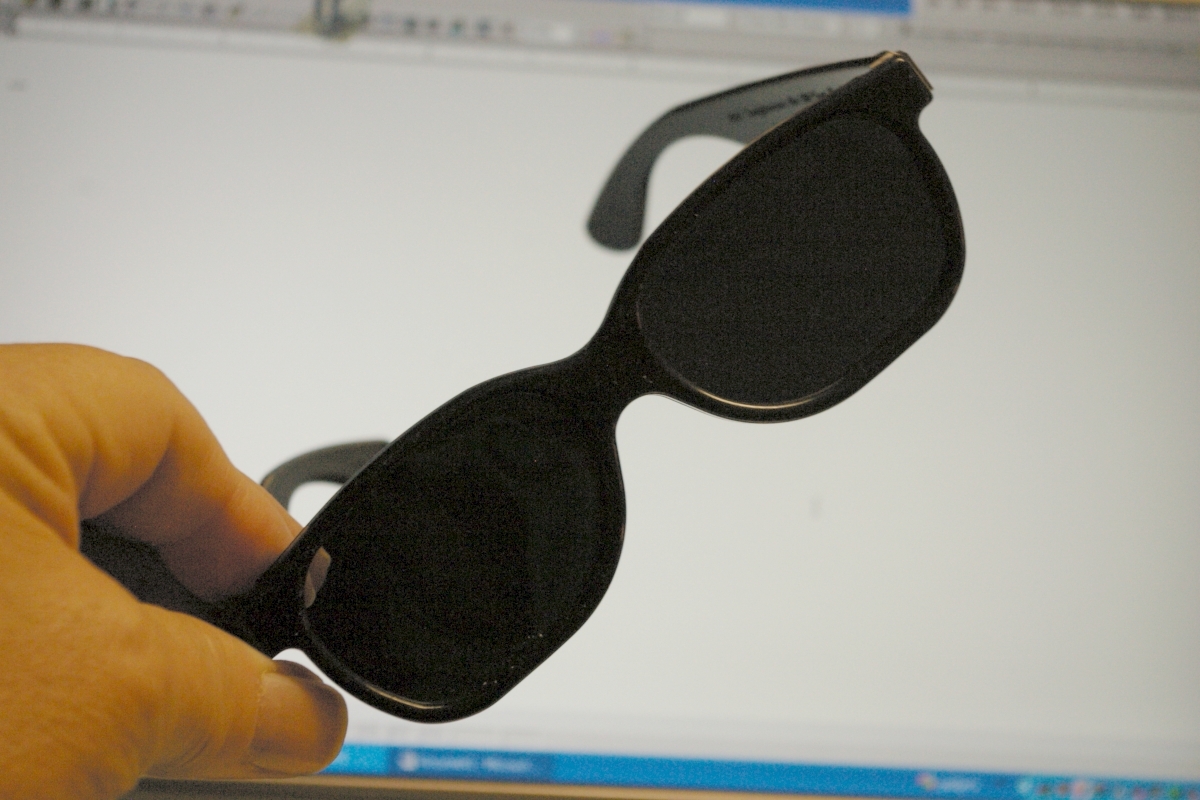 | 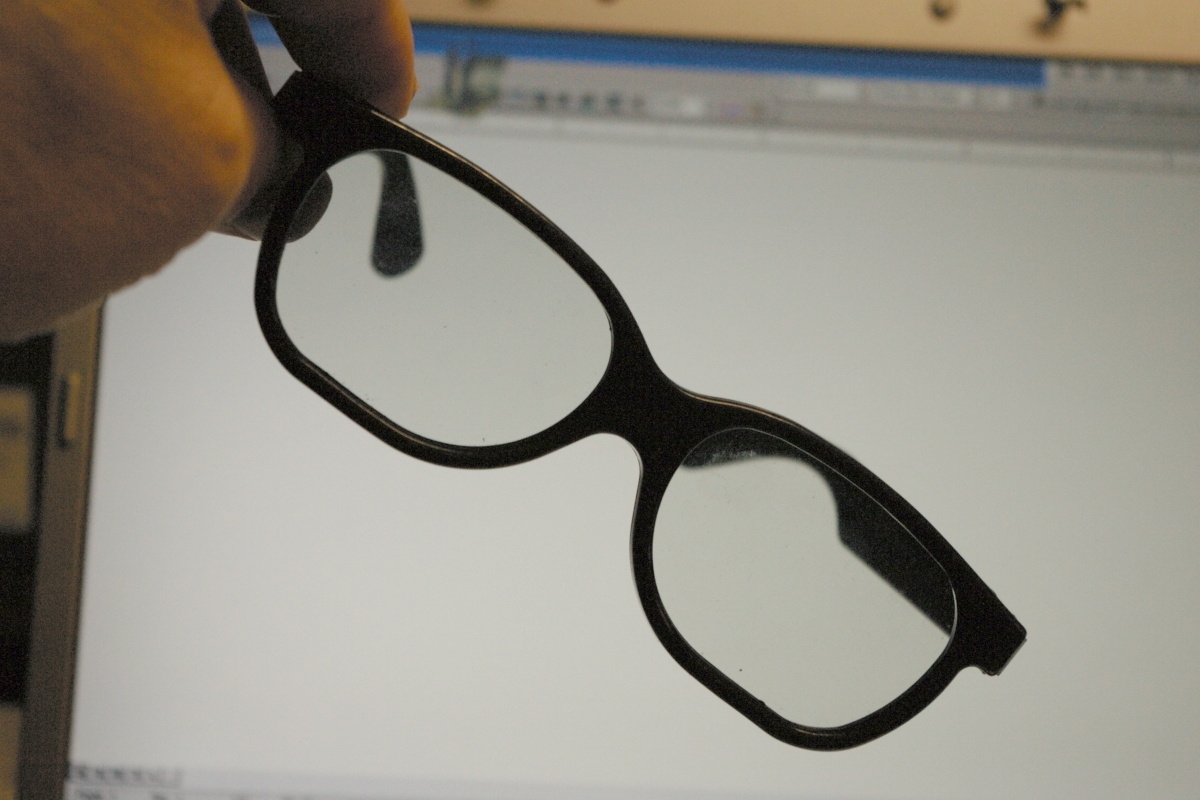 |
| Glasses block light. | Glasses transmit light. |
|---|
Creating colors. Obtain some cellophane from product wrappers, such as CDs or DVDs. While wearing your polarizing glasses, place the cellophane over the computer screen, and rotate it to different positions. In two orientations it will show strong color. Several layers, or different cellophane thickness, show different colors. Thicker layers are more pastel. Crumpled cellophane may produce an abstract work of color art. Rotate the polarizing glasses (take them off, first) and each color shifts to its complementary color. Red to green, yellow to violet, etc. You may have better results with the glasses backwards, so the polarizing layer is away from your eyes.
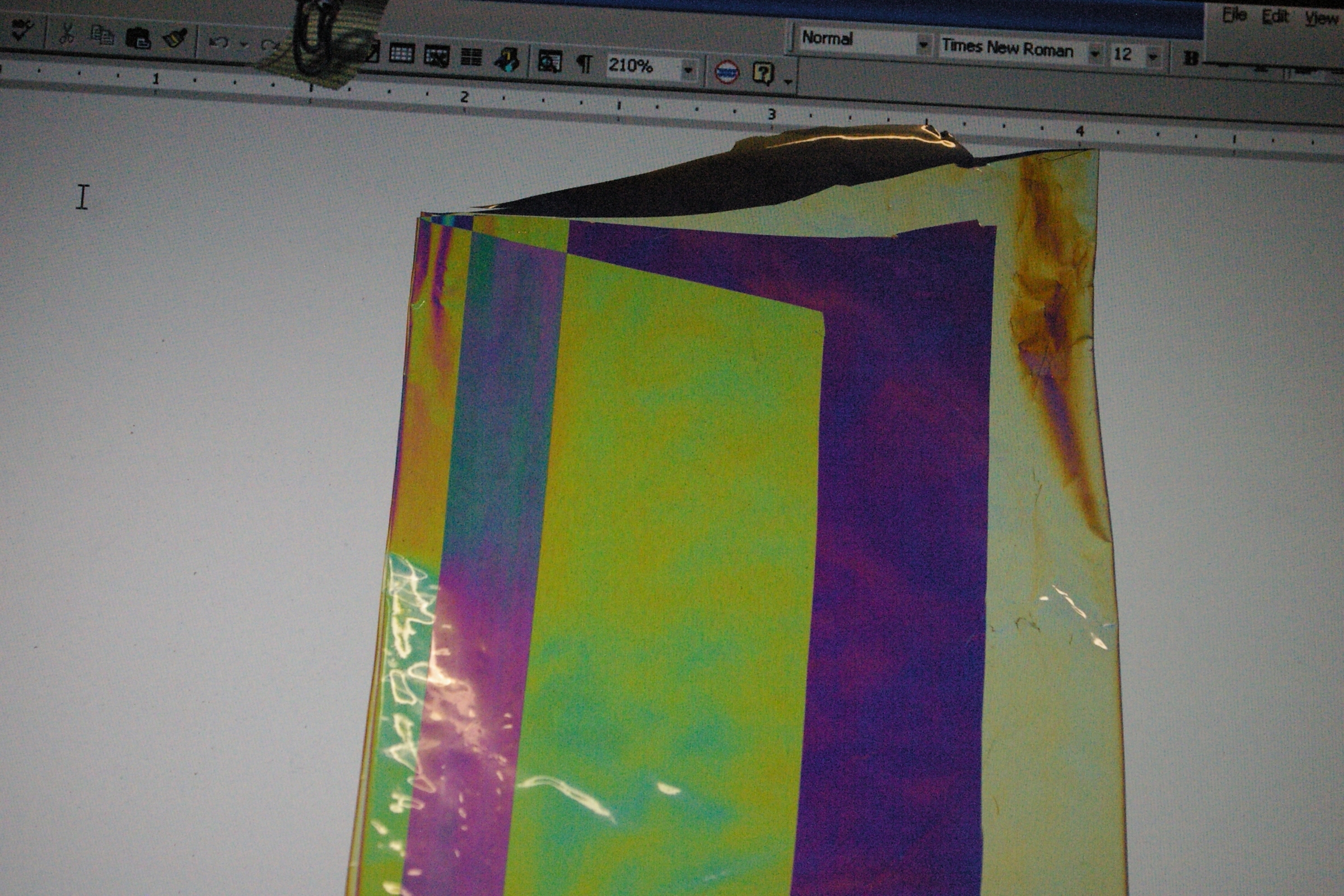 | 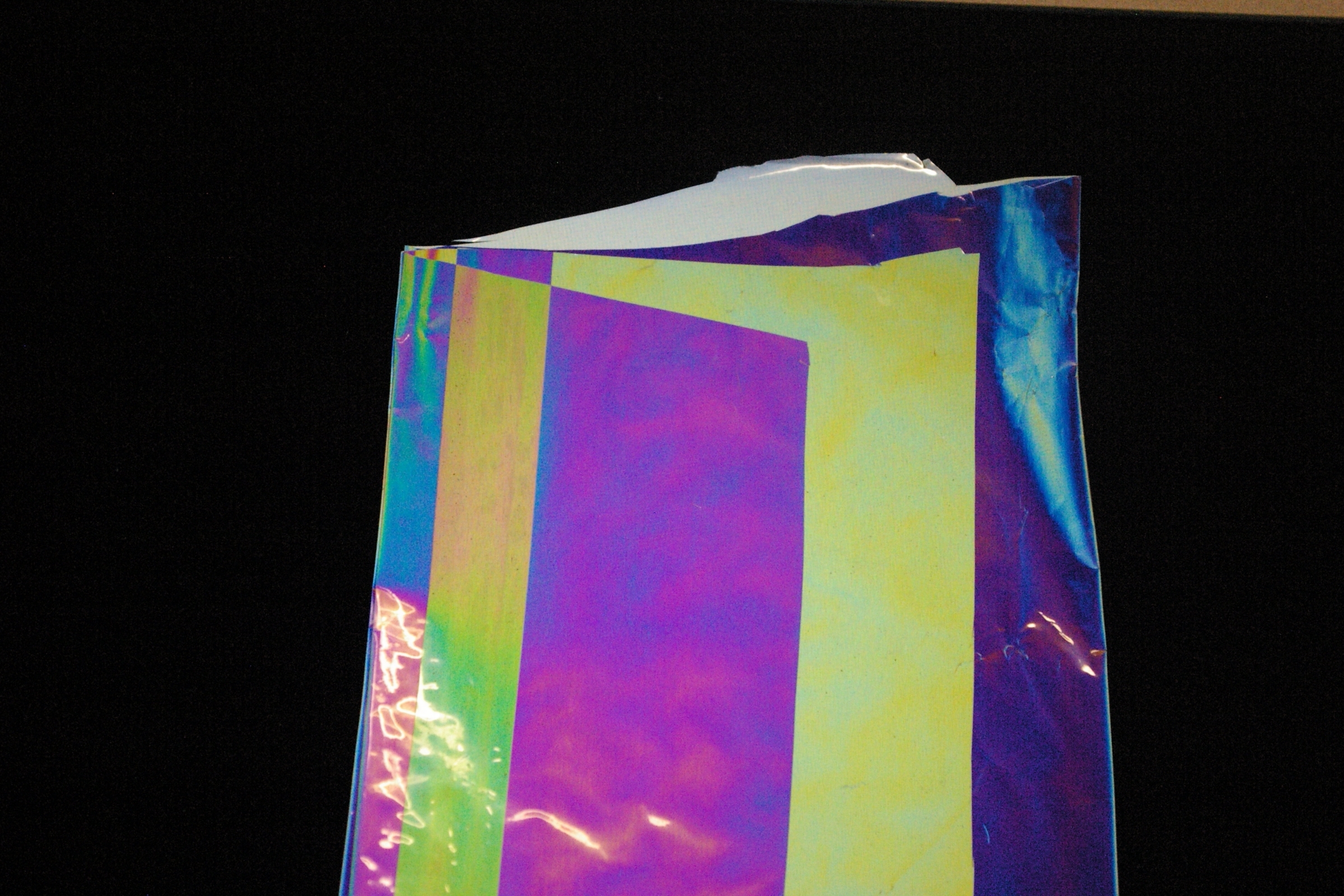 |
| Layers of cellophane between parallel polarizers. Cellophane axis at 45° to the polarizers. |
The same layers of cellophane between crossed polarizers. One polarizer has been rotated 90° but the cellophane axis is still at 45° to the polarizers. |
|---|---|
| These pictures were taken with polarized light from a computer screen polarized at 45°to the vertical, and a linear polarizer in front of the camera lens. | |
Be artistic. Creative types might use this for making works of art. In the 19th century European craftsman made miniature scenes from carefully cut layers of thin crystals sandwiched between polarizing sheets. A sheet of aluminum foil (smooth or crumpled) could be a background for such a scene, using just one polarizer in front of everything. Be inventive.
Color everywhere. Look at samples of transparent hard plastic in the same way. Abstract patterns of many colors may be seen. Try a plastic comb, or a clear plastic container from cellophane tape. Try the cellophane tape itself, applied onto a glass sheet in various patterns and different number of layers. (Please don't stick the tape to your computer screen.)
 |  |
| Tape dispenser between crossed polarizers. |
Plastic comb between crossed polarizers. |
|---|
Polarizers for cameras. Yes, if you are "cheap" you can use either filter from the 3-d movie glasses as a camera polarizer in front of the camera lens, if you place the polarizing side away from the camera (on the side nearest the subject). This is useful for eliminating glare from shiny surfaces, increasing the color saturation of shiny leaves, and for darkening blue skies for dramatic effect. In fact, most digital camera manufacturers specify that only circular polarizers be used for this purpose, not linear polarizers. This is because digital camera autofocus and autoexposure systems usually have an internal mirror to deflect and monitor a fraction of the incoming light, and mirrors polarize the light. So a linear polarizer could, in certain orientations, compromize the accuracy of these important systems. The incoming light from the scene passes through the linear polarizer, which does its job of reducing reflections. Then the light passes through the retarding plate which converts it to circular polarization, which, being unbiased laterally, cannot confuse the automatic camera systems. These inexpensive 3-d glasses are not optical quality, so they will introduce some slight degradation of resolution and sharpness of the image. But you may not even notice the difference.
For my own follow-up to this article, see Experiments with Polarized Light.
You can find out more about polarization, with experiments you can easily do, at: Polarization (elementary).
For a mathematical treatment of the theory, and lots of good experiments you can do at home, see http://instructor.physics.lsa.umich.edu/int-labs/Chapter4.pdf. Your Real-D™ glasses provide the equivalent of the raw materials specified in this document.